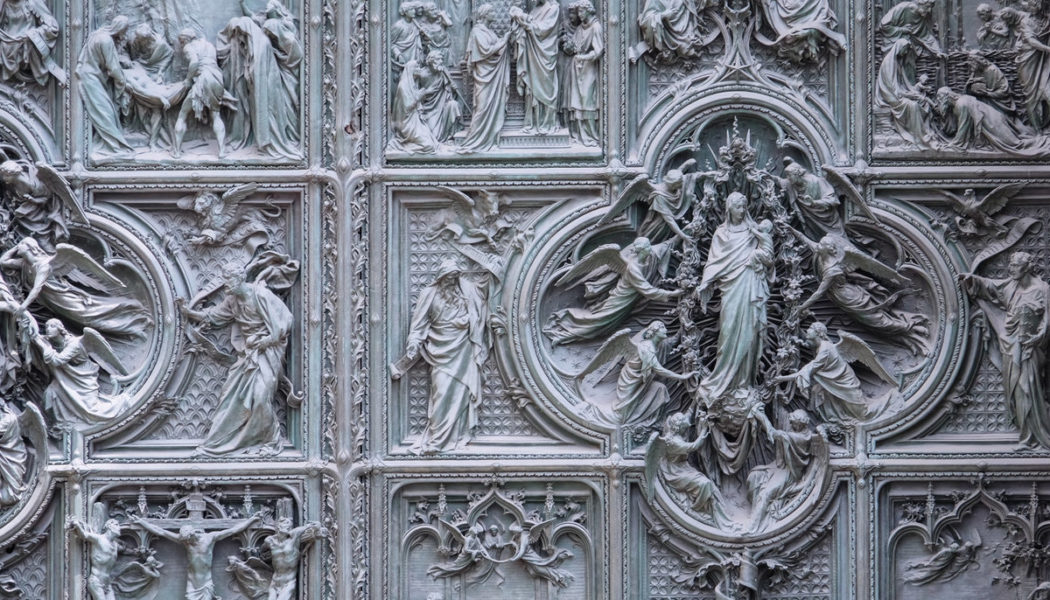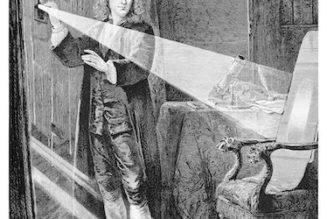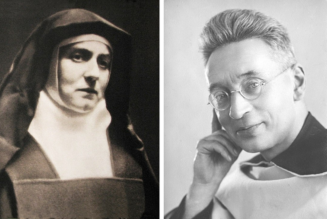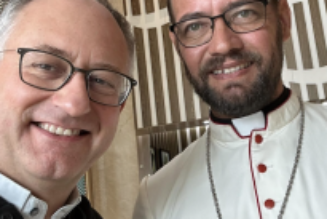
By Carrie Gress
Historian Arnold Toynbee, after studying the fall of 26 great civilizations, concluded: “Civilizations die from suicide, not by murder.” They become hollowed out from within, like an old rotting tree, and then come crashing down with an autumn’s breeze. Given the crisis upon crisis of the last few years, it seems we have a front row seat for the latest iteration of societal suicide.
When I published the book The Marian Option: God’s Solution to a Civilization in Crisis back in 2017, there were certainly major societal shifts taking place in the culture, but the book came out before COVID and before what we are watching in real time first in Afghanistan and now in Ukraine. The book has aged well and seems more relevant than ever, especially with Pope Francis’s upcoming consecration of Russia and Ukraine to Our Lady of the Immaculate Conception on her great feast, The Annunciation, on March 25th. Millions of Catholics are praying to her, asking for her intercession, in this bloody and terrible war.
The Marian Option has provided great hope and solace to those who have read it (and even to its author). Below is Chapter 2 of the book, to offer a glimpse of the hope we can place into the hands of Our Lady, to continue to guide, protect, and lead all us to her Son.
CHAPTER 2 The Most Powerful Woman in the World
When in Italy, if you ask the name of a relatively unknown church, the response is likely Santa Maria della Qualcosa, or “St. Mary of Something,” testifying to the number of churches in Italy named after Our Lady. It seems that every little town—from Seville to St. Petersburg and every pocket of Catholicism in
between—has at least one, if not several, churches devoted to Our Lady. Rome alone has roughly ninety. Many are filled with votive or thanksgiving offerings testifying to the prayers answered through Mary’s intercession, among them crutches, glasses, photographs, and paintings.
In 1900, Henry Adams (1838–1918), grandson of President John Quincy Adams and great-grandson of President John Adams, had a keen insight. In his work The Education of Henry Adams, he explains the wonder and ignorance he felt as a young man at the World’s Fair while experiencing the power of new machines, especially the automobile. While he found himself stupefied by the invention, he was thrilled by its potential and what it heralded for the future of science. But then Adams retreats a bit from his awe and wonder and compares the likes of it to the power wielded throughout the centuries by the notion of a virgin. He starts initially describing those found among the Greeks and Romans, but eventually his descriptions include the Virgin Mary. He explains, “The twelfth and thirteenth centuries were a period when men were at their strongest; never before or since have they shown equal energy in such varied directions, or such intelligence in the direction of their energy; yet these marvels of history—these Plantegenets [a dynastic family of kings]; these Scholastic philosophers; these architects of Rheims and Amiens; these Innocents, and Robin Hoods, and Marco Polos; these crusaders who planted their enormous fortresses all over the Levant; these monks who made the wastes and barrens yield harvest—all, without apparent expedition, bowed down before the woman.”
Even the potential power of the dynamo (the automobile) is nothing, Adams explains, compared to the power of the Virgin. What Henry Adams recognized more than a century ago (even more surprisingly as a Protestant) as he walked through the cities, churches, cathedrals, and cemeteries, was that the height of European culture was centered on devotion to Our Lady. In the places where
European culture soared, so too did devotion to Our Lady, and perhaps vice versa: where devotion to Mary soared, so too did culture.
Henry Adams isn’t the only one to have this insight about Mary. In 2015, National Geographic named her the “World’s Most Powerful Woman.” Maureen Orth explained:
Mary is everywhere: Marigolds are named for her. Hail Mary passes save football games. The image in Mexico of Our Lady of Guadalupe is one of the most reproduced female likenesses ever. Mary draws millions each year to shrines such as Fatima, in Portugal, and Knock, in Ireland, sustaining
religious tourism estimated to be worth billions of dollars a year and providing thousands of jobs. She inspired the creation of many great works of art and architecture (Michelangelo’s “Pietà,” Notre Dame Cathedral), as well as poetry, liturgy, and music (Monteverdi’s Vespers for the Blessed Virgin). And she is the spiritual confidante of billions of people, no matter how isolated or forgotten.
Mary is everywhere—sometimes hiding in plain sight. Her influence in the world is unmistakable if looked at collectively through salvation history.
In the previous chapter, we saw that creative minorities are responsible for setting the wheels of civilizations aright. What has been overlooked for centuries, however, is Mary’s role in creative minorities. Not only did she play a role in them, but she has been the force behind some of the most successful creative minorities in history. Looking back to when devotion to her expanded in the Church—say, from the thirteenth century, when St. Dominic promoted the Rosary (although one could argue even earlier)—Mary has been the source behind the Catholic creative minorities that have ushered in massive geopolitical shifts. In battle after battle against Christianity’s enemies, those led by her have been victorious. For example, Catholic Spain, fighting under her standard, is one of the only countries to regain vast amounts of territory from Islam. Elsewhere, outnumbered Christians were victorious against the Ottomans in the battles of Lepanto and Vienna after begging for Mary’s assistance through the Rosary. In the Americas, Our Lady of Guadalupe dramatically transformed the history of the continent by converting at least four million natives to Catholicism (some estimates are as high as ten million). And in Cold War Poland, a priest of little consequence was called from the ashes of World War II and Soviet Communism to conquer the Iron Curtain. In country after country, from Austria to Ukraine, some national miracle has been attributed to her intercession.
Mary is truly at the heart of many creative minorities that have transformed the world. She doesn’t need the masses to change; she just needs a few devoted souls, such as St. Dominic, St. Ferdinand III, Blessed Alan de la Roche, Jan Sobieski, St. Catherine Labouré, three children in Fatima, or Pope St. John Paul II. She also works through the hidden souls known only to her, who transform the world through their prayers, sacrifices, and pure love. Cardinal Joseph
Mindszenty (1892–1975), who was imprisoned first by the Nazis and then by the Communists in Hungary for twenty-three years, said of her, “Veneration of Mary is the great genius which gives Christianity its power, courage, and victoriousness.” Clearly this was a man who had witnessed a lot of cowardice, injustice, and outright evil. He knew that Mary and her special intercession was an antidote to all of these.
The Woman in Combat Boots
Many years ago, I heard a priest with a strong Marian devotion explain that Mary wears combat boots. It seemed an odd thing to say about the woman who is always described as exceedingly beautiful, clothed in gorgeous flowing silks and veils. And yet, if you look deeper at Mary’s influence over the centuries, the idea of her wearing combat boots looks a little more plausible.
Of the many foreshadowings of Mary found in the Old Testament, this one rings true of a beautiful woman in boots: “Who is she that cometh forth as the morning rising, fair as the moon, bright as the sun, terrible as an army set in array?” (Sg 6:10). She has been called la Conquistadora, meaning “the conqueror” (hardly a tender title)—a popular devotion that continues in the American Southwest. In the Litany of Our Lady of Sorrows, her more militant side shines through. In it, she is called Shield of the oppressed, Conqueror of the incredulous, Protectress of those who fight, Haven of the shipwrecked, Calmer of tempests, Retreat of those who groan, Terror of the treacherous, and Standard-bearer of the Martyrs. Like a fierce mama bear, there is nothing light-weight about her intercession and protection of those devoted to her. More recently, St. Maximilian Kolbe’s “Militia of the Immaculate Conception” and the Blue Army—in contrast to the Communist Red Army, formed in response to the apparitions of Fatima—also reflect her role as the twelve-star general leading her troops in a spiritual battle. One twelfth-century knight wrote, “Our Lady is powerful in battles . . . She is the hope of . . . knights who fight . . . Without her aid, knights cannot win.”
In the military battles where she is invoked, the scale is tipped in surprising ways for her warriors. In battle after battle, a similar storyline presents itself: The Christians are outnumbered, but they’ve done their spiritual homework. The fighting starts, and out of the blue, something odd happens that leads the Christians to victory. In the 1815 Battle of New Orleans during the War of 1812, General Andrew Jackson’s army of six thousand faced fifteen thousand British. The residents of New Orleans joined the Ursuline nuns in praying to Our Lady of Prompt Succor. On the morning of the battle, Mass was offered at the altar, where the statue of Our Lady of Prompt Succor had been placed, which was close enough that cannon fire could be heard in the chapel. At the very moment of Holy Communion, a courier came to the Ursuline nuns with the news that the Americans had won. The British, who had been counting on advancing under the cover of fog, were exposed and routed when the mist unexpectedly lifted at the very moment the Mass was offered. The British lost two thousand soldiers, while the Americans lost seventy-one. President James Monroe later praised General Jackson, saying, “History records no example of so glorious a victory obtained with so little bloodshed on the part of the victorious.” Years later, whenever Andrew Jackson visited New Orleans, he made a point of visiting the Ursuline Convent.
Similarly, during the Polish-Soviet War in the summer of 1920, during the Battle of Warsaw, it appeared that the Soviets would have an easy time defeating the disorganized Poles. Then on August 15—which would become the date of the Feast of Our Lady’s Assumption—as the Russian army was approaching the Vistula River, an image of the Our Lady of Częstochowa was seen in the clouds over the river, terrifying the atheistic Bolsheviks. Following a series of battles, the Red Army was defeated in what is known today as the “Miracle on the Vistula,” which halted the spread of Communism into Western Europe.
And again, in 1986 in the Philippines, the twenty-year dictatorship of Ferdinand Marcos was shaken up by the election of Corazon “Cory” Aquino. But as the Marcos regime came to an end, it appeared the dictator would not go out without a fight. He sent out his loyalist military, including tanks and soldiers, to keep a grip on the country through any means possible; Marcos had given orders to fire on the people if necessary. Cardinal Jaime Sin recounts the turn of events:
What I am telling you now was told to me by many of these same soldiers who were ready to fire on the people. The tanks were trying to penetrate the crowd. And the people were praying and showing their rosaries. That is when, according to these soldiers, the Marines who were riding on top of the tanks, the so-called Loyalists (to Marcos), they saw up in the clouds the form of the cross . . . Then, a beautiful lady appeared to them.
I don’t know if she appeared in the sky or was standing down on the ground. (Others would later tell me they thought she was a nun, dressed in blue, and that she was standing in front of the tanks.) So beautiful she was, and her eyes were sparkling. And the beautiful lady spoke to them like this: “Dear soldiers, stop! Do not proceed! Do not harm my children!” And when they heard that, the soldiers put down everything. They came down from the tanks and they joined the people. So, that was the end of the Loyalists. I don’t know who these soldiers are. All I know is that they came here crying to me. They did not tell me that it was the Virgin. They told me only that it was a beautiful sister. But you know, (he paused, laughing heartily), I have seen all the sisters in Manila, and there are no beautiful ones. So it must have been the Virgin!
Reports say there were more than one million Filipino men, women, and children praying together in the streets, holding their rosaries as the soldiers advanced. The Marcos regime ended without massive bloodshed, thwarted at the last minute by the faith-filled prayers of a million people and the woman who wears combat boots.
Queen of Peace
Mary’s strength is not just military or political. At its heart, her influence is always directed to the will of Christ and the salvation of sinners, but with a maternal touch. Like a good mother, she brings peace to those in difficult situations. When Our Lady appeared to St. Catherine Labouré, Mary told her that France would undergo terrible political struggles for forty years, and the whole world would be in sadness. “The moment will come,” Mary explained to Catherine, “when the danger will be enormous; it will seem that all is lost; at that moment, I will be with you; have confidence.” And just as Mary said, there were forty years of political upheaval and religious persecution both in France and elsewhere. Wars continued, including the Civil War in the United States and the Prussian invasion of France. The darkest hour for St. Catherine and France foretold by Mary was the Paris Commune in 1871. The raging Communards sieged Paris through bloody street fighting, desecrating churches and tombs of saints. Even the archbishop was assassinated. When the Communard ruffians took over part of St. Catherine’s convent, the nuns were forced to scatter to other convents to protect themselves against the drunken mob of rapacious men. The forewarnings Mary gave to St. Catherine, however, gave her an unflappable calm, even at the darkest moments.
As we will see in later chapters, saint after saint speaks of the peace, consolation, and confidence that Our Lady instilled in their hearts—no matter how grave the circumstances.
Mary has shown herself as a mother and the Queen of Peace the world over. There are apparition sites dotting the planet. A visit to the National Shrine of the Immaculate Conception in Washington, DC, makes Mary’s connection to the nations of the world abundantly clear, with its seventy chapels dedicated to the Blessed Mother’s international influence, from China to Africa, from Austria to
Vietnam. So many countries (Catholic and non-Catholic) have been on the receiving end of her great graces and now feature shrines to her that are sources of grace, blessing, and peace. They remind us of the words of St. Peter Damian, who said that Mary is “the Mother of true Peace.”
Beyond the Battlefield
When most battles are concluded, military personnel move on to another battle. Mary’s influence, however, doesn’t stop at routing enemies; it extends into transforming the landscape. She fortifies the community and country through the workings of culture.
As we saw in the previous chapter, in the order of history (though not in the order of grace), Our Lady’s more tangible influence in the world followed that of St. Benedict. He brought order and stability to monasteries and the societies that grew up around them. There was an essential scouring of all things pagan, a belief system that had proliferated under the Roman Empire. The Dark Ages cleaned nature and creation in the collective minds of Western civilization of pagan associations and left the world anew again, like pure soil in which culture and society could finally take root and grow properly. This is not to say that these societies were without sin or scoundrels but that there was a fundamental understanding among men and women of who God was and their relationship to Him. From this strong starting point—like a sturdy foundation—culture could be built. It is no accident that devotion to Our Lady increased dramatically after the scouring of paganism.
Looking at history, cultures are transformed through simple devotion to her. A wise priest once defined culture as “God’s love made visible.” Mary is the masterpiece of God, which explains why when Marian devotion flourishes, so too does culture. Mary as our mother brings order to those places where she is invoked and honored. As Blessed John Henry Cardinal Newman, a convert from Anglicanism to Catholicism, explained, Mary is our “happier world.” She leads her spiritual children to her Son and helps us regain what has been lost through the Fall and sin. She rids us of false teaching. Far from a saccharine devotion, Mary burns through the vices of the cynic, the jaded, the angry, the agitated, and the hopeless. In their place, she plants the gifts of peace, order, hope, strength, goodness, and creativity. These new fruits in the lives of her devotees become tangible in the material elements of the culture. Her gifts ripple from one person to the next well out into the broader culture.
Join Our Telegram Group : Salvation & Prosperity








